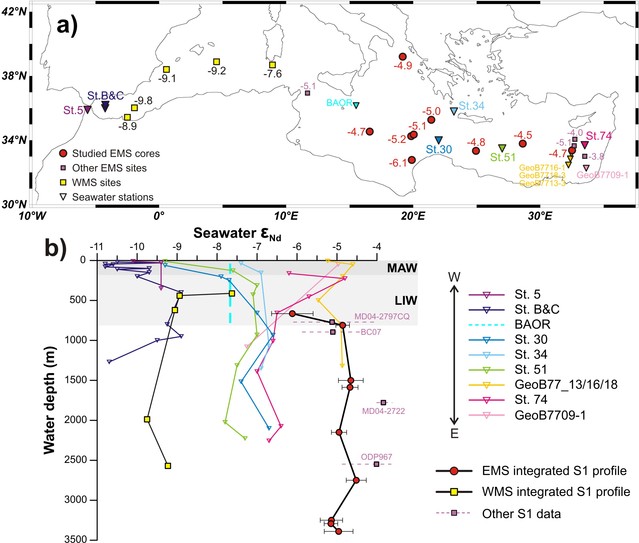Jiawang Wu a,b *, Katharina Pahnke c, Philipp Böning c, Li Wu a, Annie Michard d, and Gert J. de Lange a,b
a State Key Laboratory of Marine Geology, Tongji University, Siping 1239, 200092 Shanghai, China
b Department of Earth Sciences – Geochemistry, Faculty of Geosciences, Utrecht University, Princetonplein 9, 3584 CC Utrecht, The Netherlands
c Max Planck Research Group for Marine Isotope Geochemistry, Institute for Chemistry and Biology of the Marine Environment (ICBM), University of Oldenburg, Carl-von-Ossietzky-Strasse 9-11, 26129 Oldenburg, Germany
d CEREGE, Aix-Marseille Université, CNRS, IRD, CEREGE UM34, 13545 Aix en Provence, France
Abstract
The recurrent deposition of organic-rich sapropel layers in the eastern Mediterranean Sea (EMS) has been attributed to deep-water stagnation and enhanced biological production. However, the underlying climatic interactions, paleoceanographic processes, and associated ventilation dynamics are still debated. Here, we present a basin-wide reconstruction of circulation systematics during sapropel S1 formation (~10.8–6.1 kyr BP), using the Nd isotope composition (εNd) as paleo-seawater tracer. Our εNd data from fish debris and foraminifera tests are remarkably radiogenic compared to today, and spatially and temporally constant. These results predominantly reflect enhanced Nile versus Atlantic contributions, and indicate that EMS deep-water stagnation prevailed below ~800 m water-depth during S1 formation. Additional εNd records obtained from bulk sediment leachates show that such stagnation was preconditioned thousand(s) of years prior to S1 initiation by intensified Nile flooding, whereas it terminated with a basin-wide, deep-water renewal. In addition, decoupling of deep waters between the EMS and western Mediterranean Sea (WMS) is evident for the S1-period. Using a box-model for Nd in the EMS, the observed εNd distribution can be most adequately explained by a 2-fold increase in Nile discharge, and a 50% decrease in the EMS–WMS exchange that was mostly limited to the surface waters alone. The corresponding circulation during S1 was more sluggish and shallow for the EMS, but largely unaffected for the WMS. This implies that deep-water stagnation is a prerequisite for sapropel formation.

Full article: https://doi.org/10.1016/j.epsl.2019.01.036


